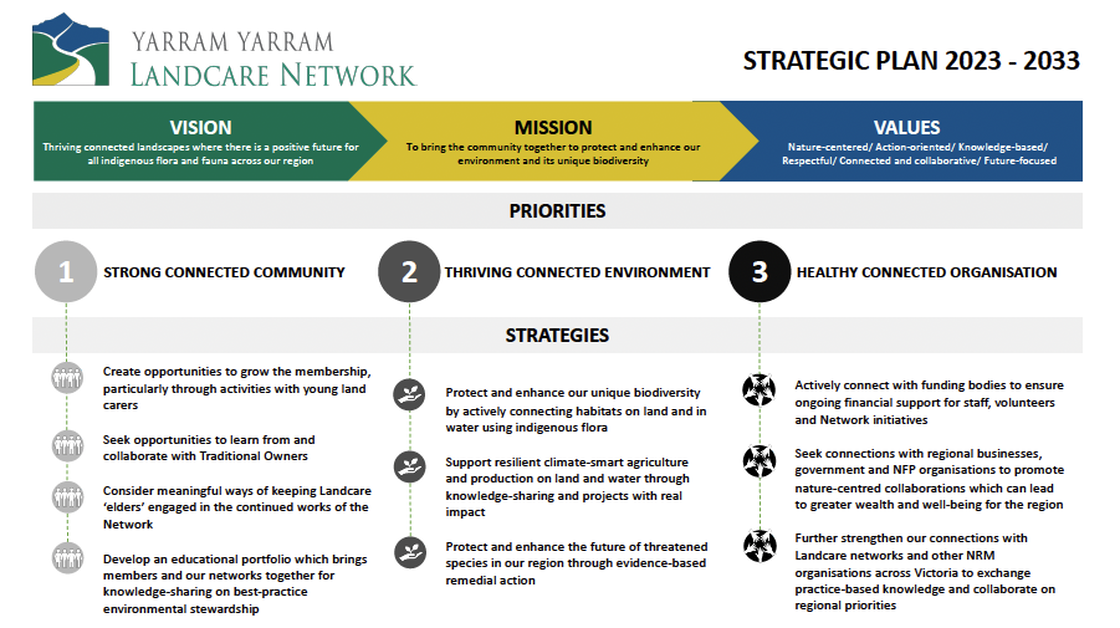YARRAM YARRAM LANDCARE NETWORK
~ connecting communities and landscapes for a better future ~
Following six months of consultation with its membership, the Board of the YYLN approved the following strategic plan in April 2023,
to guide the Network for the next ten years. The info-graphic below gives a brief snapshot of the strategy, but scroll down for more detail.
to guide the Network for the next ten years. The info-graphic below gives a brief snapshot of the strategy, but scroll down for more detail.
|
Context
YYLN spans approximately 118,000 hectares stretching from the temperate, Wet and Damp rainforests of the Strzelecki Ranges (including those in Tarra Bulga National Park) to the RAMSAR-listed wetlands of Corner Inlet and inlets of the Nooramunga Marine and Coastal Park, encompassing the Giffard Plain, along the Ninety Mile Beach to Seaspray. We are unique in South Gippsland because we have over 30% of natural vegetation in the form of large tracts of State Forest, Conservation Reserves, Bushland Reserves, roadside corridors and remnant patches on private property. From mountain to sea, we have 17 different Environmental Vegetation Classes (EVCs) and our area is home to abundant wildlife including many endangered species currently listed with the Flora and Fauna Guarantee Act as threatened in Victoria and on the National EPBC Act. We are home to the iconic Strzelecki Koala which has 15% of its estimated population within the Mullungdung forest and many others in the more fragmented landscapes interspersed with cleared farming land. The natural areas are separated by land cleared for agriculture with a number of dairy farms occupying the fertile river valleys and flats to the north and west of Yarram township and very large sheep and cattle properties on the drier coastal plains to the east of Yarram. Forestry is also |
a major industry in the area and has contributed to land-clearing in sites across the Network, and particularly in the Strzelecki Ranges. Recreational and commercial fishing and tourism are amongst other significant industries in our region. The Federal Government has also recently announced South Gippsland as the location for a forthcoming renewable energy hub.
While our membership is diverse, we are united by the desire to protect and enhance our natural environment for current and future generations. Whether we are establishing shelter belts and healthy farm dams on agricultural land, re-establishing bio-links through logged areas, or refurbishing seagrass in Corner Inlet, we are all striving to balance the need for sustainable industries across our region with the protection of our biodiversity. We have unique landscapes and an opportunity to connect these landscapes across land and waters, to ensure a healthy future for ourselves and the rich biodiversity in which we live, work and play. Together we can take this once-in-a-lifetime opportunity. |
Vision |
Thriving connected landscapes where there is a positive future for all indigenous flora and fauna across our region.
|
Mission |
To bring the community together to protect and enhance our environment and its unique biodiversity.
|
Values |
Nature-centred - maintaining a focus on what is best for our environment in all that we do
Action-oriented - driving local action for global outcomes, striving for the greatest impact through innovation Connection and collaboration - working together with all stakeholders in the best interest of our indigenous flora and fauna Respect - respecting a diversity of culture, voice and history, including the Traditional Owners on whose lands we live and work Knowledge-based - building, sharing, and applying evidence-based knowledge, traditional and new Future-focused - recognising that what we do now has a lasting impact on our region and that we have a responsibility to future generations |
YYLN STRATEGIC PLAN 2023 - 2033
PRIORITIES
Strong connected community |
Thriving connected environment |
Healthy connected organisation |
|
Grow a resilient and active membership which is connected to its local, regional and State communities through education, communication and promotion.
|
Support thriving and connected landscapes in which our members and their communities are adopting best practice in environmental stewardship, resilient agriculture and production, and sustainable living to protect our unique biodiversity.
|
Demonstrate best practice in Network governance to ensure a strong future for our staff, volunteers and expanding Network initiatives.
|
STRATEGIES
|
1. Create opportunities to grow the membership, particularly through activities with young land carers.
2. Seek opportunities to learn from and collaborate with Traditional Owners. 3. Consider meaningful ways of keeping Landcare 'elders' engaged in the continued works of the Network. 4. Develop an educational portfolio which can be shared online, via webinars and through face-to-face events, bringing members and our networks together for knowledge sharing on best-practice environmental stewardship. |
1. Protect and enhance our unique biodiversity by actively connecting habitats on land and in water using indigenous flora.
2. Support resilient climate-smart agriculture and production on land and water through knowledge sharing a projects with real impact. 3. Protect and enhance the future of threatened species in our region through evidence-based remedial action. |
1. Actively connect with funding bodies to ensure ongoing financial support for staff, volunteers and Network initiatives.
2. Seek connections with regional businesses, government and NFP organisations to promote nature-centred collaborations which can lead to greater wealth and well-being for the region. 3. Further strengthen our connections with Landcare Networks and other NRM organisations across Victoria to exchange practice-based knowledge and collaborate on regional priorities. |
ACTIONS 2023
|
|



